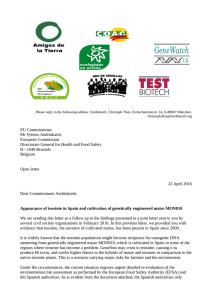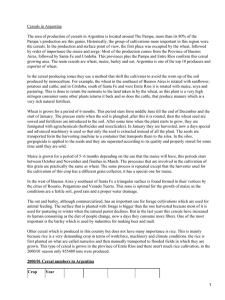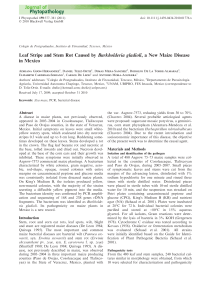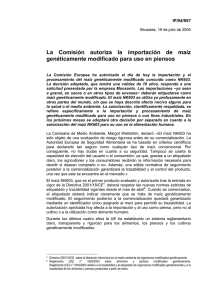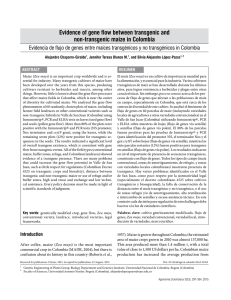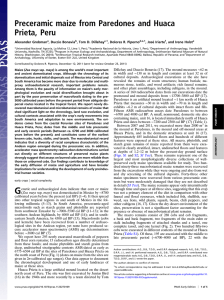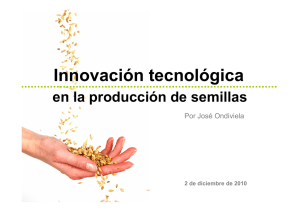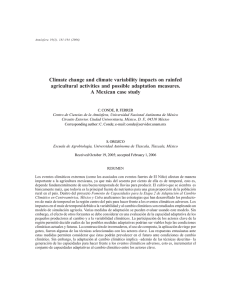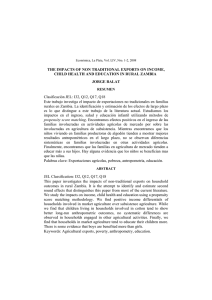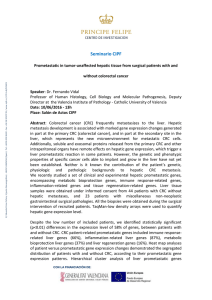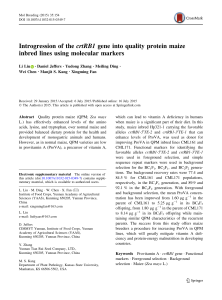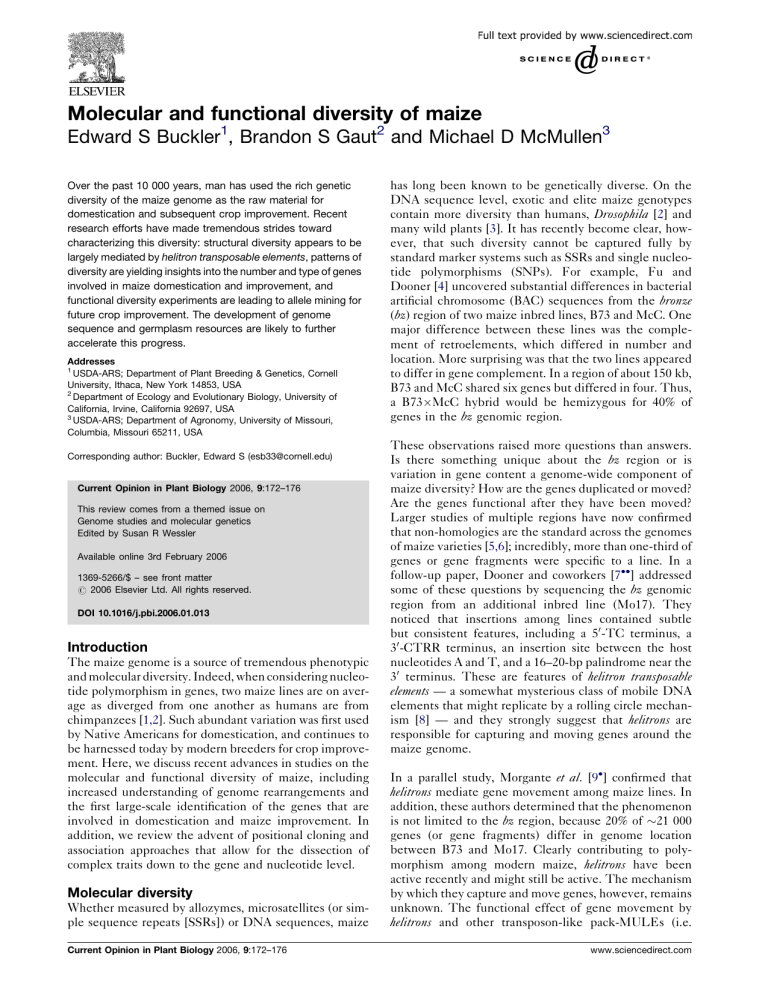
Molecular and functional diversity of maize Edward S Buckler1, Brandon S Gaut2 and Michael D McMullen3 Over the past 10 000 years, man has used the rich genetic diversity of the maize genome as the raw material for domestication and subsequent crop improvement. Recent research efforts have made tremendous strides toward characterizing this diversity: structural diversity appears to be largely mediated by helitron transposable elements, patterns of diversity are yielding insights into the number and type of genes involved in maize domestication and improvement, and functional diversity experiments are leading to allele mining for future crop improvement. The development of genome sequence and germplasm resources are likely to further accelerate this progress. Addresses 1 USDA-ARS; Department of Plant Breeding & Genetics, Cornell University, Ithaca, New York 14853, USA 2 Department of Ecology and Evolutionary Biology, University of California, Irvine, California 92697, USA 3 USDA-ARS; Department of Agronomy, University of Missouri, Columbia, Missouri 65211, USA Corresponding author: Buckler, Edward S ([email protected]) Current Opinion in Plant Biology 2006, 9:172–176 This review comes from a themed issue on Genome studies and molecular genetics Edited by Susan R Wessler Available online 3rd February 2006 1369-5266/$ – see front matter # 2006 Elsevier Ltd. All rights reserved. DOI 10.1016/j.pbi.2006.01.013 Introduction The maize genome is a source of tremendous phenotypic and molecular diversity. Indeed, when considering nucleotide polymorphism in genes, two maize lines are on average as diverged from one another as humans are from chimpanzees [1,2]. Such abundant variation was first used by Native Americans for domestication, and continues to be harnessed today by modern breeders for crop improvement. Here, we discuss recent advances in studies on the molecular and functional diversity of maize, including increased understanding of genome rearrangements and the first large-scale identification of the genes that are involved in domestication and maize improvement. In addition, we review the advent of positional cloning and association approaches that allow for the dissection of complex traits down to the gene and nucleotide level. Molecular diversity Whether measured by allozymes, microsatellites (or simple sequence repeats [SSRs]) or DNA sequences, maize Current Opinion in Plant Biology 2006, 9:172–176 has long been known to be genetically diverse. On the DNA sequence level, exotic and elite maize genotypes contain more diversity than humans, Drosophila [2] and many wild plants [3]. It has recently become clear, however, that such diversity cannot be captured fully by standard marker systems such as SSRs and single nucleotide polymorphisms (SNPs). For example, Fu and Dooner [4] uncovered substantial differences in bacterial artificial chromosome (BAC) sequences from the bronze (bz) region of two maize inbred lines, B73 and McC. One major difference between these lines was the complement of retroelements, which differed in number and location. More surprising was that the two lines appeared to differ in gene complement. In a region of about 150 kb, B73 and McC shared six genes but differed in four. Thus, a B73McC hybrid would be hemizygous for 40% of genes in the bz genomic region. These observations raised more questions than answers. Is there something unique about the bz region or is variation in gene content a genome-wide component of maize diversity? How are the genes duplicated or moved? Are the genes functional after they have been moved? Larger studies of multiple regions have now confirmed that non-homologies are the standard across the genomes of maize varieties [5,6]; incredibly, more than one-third of genes or gene fragments were specific to a line. In a follow-up paper, Dooner and coworkers [7] addressed some of these questions by sequencing the bz genomic region from an additional inbred line (Mo17). They noticed that insertions among lines contained subtle but consistent features, including a 50 -TC terminus, a 30 -CTRR terminus, an insertion site between the host nucleotides A and T, and a 16–20-bp palindrome near the 30 terminus. These are features of helitron transposable elements — a somewhat mysterious class of mobile DNA elements that might replicate by a rolling circle mechanism [8] — and they strongly suggest that helitrons are responsible for capturing and moving genes around the maize genome. In a parallel study, Morgante et al. [9] confirmed that helitrons mediate gene movement among maize lines. In addition, these authors determined that the phenomenon is not limited to the bz region, because 20% of 21 000 genes (or gene fragments) differ in genome location between B73 and Mo17. Clearly contributing to polymorphism among modern maize, helitrons have been active recently and might still be active. The mechanism by which they capture and move genes, however, remains unknown. The functional effect of gene movement by helitrons and other transposon-like pack-MULEs (i.e. www.sciencedirect.com Molecular and functional diversity of maize Buckler, Gaut and McMullen 173 Mutator-like DNA elements) [10] is also unclear. Rather than moving complete genes, helitrons appear to transfer gene fragments. Nevertheless, some of these fragments are expressed [4,11] and could affect function, either by RNA interference or by translation into protein. It seems likely that helitron-induced diversity may contribute to differences in gene expression between lines [12], dosage effects [13] and heterosis [4]. Although the non-homologies in maize genomes were surprising when first discovered, such structural diversity is consistent with allelic diversity dating back a couple of million years, and with the presence of very active mobile elements over the past few million years. The B73 genome is currently being sequenced, so a gene inventory of this line will soon be available. Although the sequencing of one individual would be sufficient to identify most of the genes of a particular species, additional lines will be required for maize because of extensive non-homologies. Thirty percent of the gene fragments in maize are non-homologous between two lines; thus, even assuming that 90% of these non-homologies are pseudogenes, sequencing one line will only identify 85% of functional genes (Figure 1). Domestication and artificial selection in maize Archaeological [14] and molecular [15] evidence indicates that modern maize (Zea mays ssp. mays) was domesticated from teosinte in southern Mexico between 6600 and 9000 years ago. Isozyme [16] and microsatellite [15] data pinFigure 1 Expected proportion of the functional gene space captured depending on the number of maize lines sequenced. These rough approximations assume the infinite allele model for the varying levels of non-homologies between pairs of lines and a total population size of 100 lines. Some data suggest that 30% of the genes are nonhomologous between two lines, so the 3% plot is equivalent to assuming that 10% of the non-homologies are functional and 90% are non-functional. www.sciencedirect.com point the annual Balsas teosinte (Zea mays ssp. parviglumis) as the direct progenitor to maize. Dispersal occurred rapidly, with evidence of cultivation in South America more than 6000 years ago [17]. Selection soon followed: favorable alleles at loci controlling plant morphology and kernel nutritional quality were fixed at least 4400 years ago [18], and further selection by Native Americans saw maize adapt to numerous varied environments. More recently, selection by plant breeders has focused on the derivation of inbred lines that are suitable for the production of hybrid maize. In the domestication phase, selection was probably focused on making maize cultivatable and improving access to the seed, while during the improvement phase, selection focused on yield, grain quality, and agro-ecosystem adaptations. Maize domestication and subsequent selection events necessarily reduced genetic diversity in the maize genome when compared to its progenitor population [19]. To estimate the parameters of this genetic loss, Wright et al. [20] compared SNP diversity between maize inbreds and teosintes in 774 genes. Two classes of maize genes were identified: those consistent with a domestication bottleneck of moderate intensity, and a second class that experienced a much greater reduction of genetic diversity consistent with artificial selection. If the 2–4% of genes belonging to this latter class are representative of the larger genome, approximately 1200 genes bear a signature of selection that is consistent with being direct targets of selection. Despite these population bottlenecks, however, inbred maize lines exhibit high levels of nucleotide diversity, retaining up to 60% of the diversity of Zea mays ssp. parviglumis and 80% of the diversity of the landraces [2]. To identify these targets of selection and the traits they control, maize researchers have employed both studies directed at logical candidate genes for differences between teosinte and maize and unbiased genomic screens for selected genes. Quantitative trait locus (QTL) analysis of populations derived from crosses of teosinte to maize identified five major domestication QTL [21]. A combination of transposon tagging, candidate-gene testing and map-based cloning subsequently led to the isolation of the genes underlying three of these QTL. The teosinte branched1 locus [22] on chromosome 1 and the barren stalk1 locus [23] on chromosome 3 interact to control lateral meristem formation, thus converting the lateral branches of teosinte into the maize ear. Selection at the teosinte glume architecture1 (tga1) locus [24,25] was responsible for transforming the hard cupulate fruitcase of teosinte into the uncovered grain of the maize ear, a key step in making teosinte an edible crop. The role of a fourth gene, ramosa1, in shaping maize ear morphology has also been recently identified [26]. Confirming the proposal by Doebley and Lukens [27] that targets of selection in the evolution of plant morphology will often be transcription regulators, all four of these genes encode Current Opinion in Plant Biology 2006, 9:172–176 174 Genome studies and functional genomics transcription factors. A direct analysis of maize candidate genes that encode enzymes involved in starch metabolism demonstrated that artificial selection on starch quality occurred during crop improvement [28]. Increased use of unbiased genomic screens to identify targets of selection [20,29,30] has greatly expanded our knowledge of the number and scope of the genes that have been involved in the improvement process. New data suggest that auxin-regulated growth, stress responses, maturation and amino-acid composition are all traits with a history of artificial selection [30]. Once a comprehensive understanding of selected genes and their corresponding traits is obtained, we can begin to modify plant breeding strategies by reintroducing genetic variation that has been lost to selection for key agronomic traits. Maize functional diversity In the past few years, maize researchers have made tremendous strides in the identification of genes and nucleotides that control quantitative variation. Most of the phenotypic variation in a species is controlled by polymorphisms at numerous genes; these polymorphisms are the functional basis of quantitative trait loci (QTL). Most crop improvement relies on selecting these numerous QTL. QTL mapping in particular, has been pioneered in maize over the past two decades, with roughly 100 research studies published in this area during the past two years alone. Given that the average maize gene houses a couple of hundred common polymorphisms and even 20–30 amino acid polymorphisms that segregate among a diverse collection of lines, geneticists must decipher how all of these genes affect quantitative traits. Three major approaches are being used to evaluate this tremendous diversity: F2-derived QTL mapping, positional cloning, and association mapping. Mapping using F2-derived populations continues at a great pace for numerous traits, including developmental traits, physiological responses [31], and biochemical makeup [32]. The intermated B73 Mo17 mapping populations [33] serve as an invaluable resource for these studies, improving the resolution of QTL mapping 3–4 fold. Many more studies will make use of these intermated populations in the near future, leading to the dissection of numerous QTL, particularly as results are integrated and anchored with the physical map. Researchers of complex traits have debated whether quantitative variation is the product of numerous small QTL or a wide distribution with both large- and smalleffect QTL. F2-derived QTL mapping was used to gain insight into this basic genetic architecture of maize. In one study, two elite inbred lines were crossed and mapped in a 1000-individual population in numerous environments [34]. In a second study, the high and low lines derived from 70 generations of long-term selection Current Opinion in Plant Biology 2006, 9:172–176 were crossed, intermated, and mapped [35]. Interestingly, both of these studies documented numerous QTL of very small effect. As experimental design in both cases included high statistical power and robust innovative analyses, numerous QTL of small effect might be the norm for the maize genome. However, both the two pairs of parental lines used for these populations are probably only tapping a small proportion of maize functional variation: founders of the elite inbred lines were targets of breeding selection for more than 50 years, a process that might have eliminated all large-effect QTL, whereas the long-term selection founders comprised a single farmer’s field that could have contained little genetic diversity. Additional research utilizing more diverse maize germplasm will be needed to resolve this issue. The positional cloning of QTL in maize has historically been problematic because of the genome’s large size and the presence of many retrotransposons [36]. With the development of physical maps, however, it is now possible to positionally clone maize QTL. The maize domestication gene tga1 was the first to be positionally cloned, by examining more than 3000 segregating plants and then mapping to within a 1042-bp fragment [25]. The flowering time locus vegetative to generative transition 1 (vgt1) has also been positionally cloned, and its position subsequently confirmed by association mapping ([37]; Savli et al., 2005 Maize Genetics Meeting Abstracts). Once the maize genome is completely sequenced, positional cloning of QTL should become even more routine. Indeed, as maize boasts a higher centiMorgan to gene ratio than Arabidopsis, the total number of plants and meioses needed for positional cloning of QTL will be less in maize than in Arabidopsis. In contrast to linkage mapping, association mapping relies on surveys of natural variation, exploiting the rich history of alleles and recombination gained through evolution. In these approaches, diversity is evaluated across natural populations, and polymorphisms that correlate with phenotypic variation are identified. Because no mapping population need be created, association tests are much faster than alternative linkage methods, and also enjoy higher resolution. This high resolution is dependent upon the structure of linkage disequilibrium (LD), or the correlation between polymorphic loci within the test population [38]. LD dictates experimental design, with the distance over which LD persists determining the number and density of required markers. LD decays rapidly in maize, making this phenomenon an ideal tool for association studies: in landraces and a broad sample of tropical and temperate inbreds, LD often declines to nominal levels within 1.5 kb [2,39], whereas elite breeding material has less rapid decay [40,41]. Although used extensively to study the genetic basis of human diseases, association mapping has only recently www.sciencedirect.com Molecular and functional diversity of maize Buckler, Gaut and McMullen 175 been applied to maize and other plant populations [42– 45]. Association mapping has identified the candidate nucleotides that affect starch [46], carotenoid [44], and maysin content [47]. Improvements continue to be made to the mapping process itself, including the development of novel statistical approaches that control for pedigree and population adaptations [48], the integration of epistatic interactions in the dissection of complex traits [47], and the identification of limitations related to population structure [49]. Because current association analysis in maize is candidate gene driven, however, we are still limited to working with known pathways and genes. To resolve this issue, a nested association mapping (NAM) population is being created for the maize community (www.panzea.org). In this population, two different scales of LD are created by crosses between 27 very diverse lines. The two scales of LD and large sample size will permit a very high resolution genomic scan. Conclusions The future of maize research is promising. Advances in experimental design and the increased availability of germplasm resources move us ever closer to dissecting the molecular and functional diversity of maize. Mapping QTLs to the level of individual genes will provide new insights into the molecular and biochemical basis for quantitative trait variation, and will identify novel targets for crop improvement for the 21st century. Acknowledgements We thank N Stevens for technical editing of this manuscript. This work was supported by the US National Science Foundation (DBI-0320683 and DBI-0321467) and the US Department of Agriculture – Agricultural Research Services (USDA-ARS). References and recommended reading Papers of particular interest, published within the annual period of review, have been highlighted as: of special interest of outstanding interest 1. The Chimpanzee Sequencing and Analysis Consortium: Initial sequence of the chimpanzee genome and comparison with the human genome. Nature 2005, 437:69-87. 2. Tenaillon MI, Sawkins MC, Long AD, Gaut RL, Doebley JF, Gaut BS: Patterns of DNA sequence polymorphism along chromosome 1 of maize (Zea mays ssp. Mays L.). Proc Natl Acad Sci USA 2001, 98:9161-9166. 3. Wright SI, Gaut BS: Molecular population genetics and the search for adaptive evolution in plants. Mol Biol Evol 2005, 22:506-519. 7. Lai J, Li Y, Messing J, Dooner HK: Gene movement by Helitron transposons contributes to the haplotype variability of maize. Proc Natl Acad Sci USA 2005, 102:9068-9073. This paper, a follow up to the landmark Fu and Dooner paper [4], was the first to establish that structural differences between maize lines are due to helitron transposition. The authors also established that the genes that have been captured and moved by helitrons appear to be predominantly pseudogenes. 8. Kapitonov VV, Jurka J: Rolling-circle transposons in eukaryotes. Proc Natl Acad Sci USA 2001, 98:8714-8719. 9. Morgante M, Brunner S, Pea G, Fengler K, Zuccolo A, Rafalski A: Gene duplication and exon shuffling by helitron-like transposons generate intraspecies diversity in maize. Nat Genet 2005, 37:997-1002. This paper confirmed that helitrons cause structural polymorphism and established the genome-wide nature of the phenomenon. 20% of gene fragments were not found in syntenous locations in two maize inbred lines, presumably because of helitron activity. 10. Jiang N, Bao Z, Zhang X, Eddy SR, Wessler SR: Pack-MULE transposable elements mediate gene evolution in plants. Nature 2004, 431:569-573. 11. Brunner S, Pea G, Rafalski A: Origins, genetic organization and transcription of a family of non-autonomous helitron elements in maize. Plant J 2005, 43:799-810. 12. Guo M, Rupe MA, Zinselmeier C, Habben J, Bowen BA, Smith OS: Allelic variation of gene expression in maize hybrids. Plant Cell 2004, 16:1707-1716. To our knowledge, this was the first use of F1 (hybrid) individuals to assess allelic variation in gene expression in plants. In hybrids, the two alleles share a common genetic background, thus eliminating background effects and trans-acting factors as contributors to observed variation. Eleven of 15 genes exhibited allelic variation in expression, a higher proportion than observed in animals. The authors propose that widespread differences in allele expression could contribute to heterosis. 13. Dilkes BP, Comai L: A differential dosage hypothesis for parental effects in seed development. Plant Cell 2004, 16:3174-3180. 14. Piperno DR, Flannery KV: The earliest archaeological maize (Zea mays L.) from highland Mexico: new accelerator mass spectrometry dates and their implications. Proc Natl Acad Sci USA 2001, 98:2101-2103. 15. Matsuoka Y, Vigouroux Y, Goodman MM, Sanchez GJ, Buckler ES, Doebley JF: A single domestication for maize shown by multilocus microsatellite genotyping. Proc Natl Acad Sci USA 2002, 99:6080-6084. 16. Doebley JF, Goodman MM, Stuber CW: Isoenzymatic variation in Zea (Gramineae). Syst Bot 1984, 9:203-218. 17. Bush MB, Piperno DR, Colinvaux PA: A 6,000 year history of Amazonian maize cultivation. Nature 1989, 340:303. 18. Jaenicke-Despres V, Buckler ES, Smith BD, Gilbert MTP, Cooper A, Doebley J, Pääbo S: Early allelic selection in maize as revealed by ancient DNA. Science 2003, 302:1206-1208. An innovative study in which the authors conducted SNP analysis on archaeological cob samples to date the fixation of maize-like polymorphisms at domestication genes. The study demonstrated that by 4400 years ago, Native American agriculturists had already dramatically affected the diversity of three genes that control morphological and nutritional traits in maize. 19. Tenaillon MI, U’Ren J, Tenaillon O, Gaut BS: Selection versus demography: a multilocus investigation of the domestication process in maize. Mol Biol Evol 2004, 21:1214-1225. 4. Fu H, Dooner HK: Intraspecific violation of genetic colinearity and its implications in maize. Proc Natl Acad Sci USA 2002, 99:9573-9578. 5. Brunner S, Fengler K, Morgante M, Tingey S, Rafalski A: Evolution of DNA sequence non-homologies among maize inbreds. Plant Cell 2005, 17:343-360. 20. Wright SI, Bi IV, Schroeder SG, Yamasaki M, Doebley JF, McMullen MD, Gaut BS: The effects of artificial selection on the maize genome. Science 2005, 308:1310-1314. The first large-scale application of the use of nucleotide polymorphism data to identify genes of potential agronomic importance by the signature of selection. The approach included substantial methodological improvement to test for selection. The authors estimate that 2–4% of their sample of 774 genes bear the signature of selection, suggesting that domestication and crop breeding has targeted a large number of loci genome-wide. 6. Song R, Messing J: Gene expression of a gene family in maize based on noncolinear haplotypes. Proc Natl Acad Sci USA 2003, 100:9055-9060. 21. Doebley J, Stec A: Inheritance of the morphological differences between maize and teosinte: comparison of results for two F2 populations. Genetics 1993, 134:559-570. www.sciencedirect.com Current Opinion in Plant Biology 2006, 9:172–176 176 Genome studies and functional genomics 22. Doebley J, Stec A, Hubbard L: The evolution of apical dominance in maize. Nature 1997, 386:485-488. 23. Gallavotti A, Zhao Q, Kyozuka J, Meeley RB, Ritter MK, Doebley JF, Pe ME, Schmidt RJ: The role of barren stalk1 in the architecture of maize. Nature 2004, 432:630-635. 24. Dorweiler J, Stec A, Kermicle J, Doebley J: Teosinte glume architecture 1: a genetic locus controlling a key step in maize evolution. Science 1993, 262:233-235. 25. Wang H, Nussbaum-Wagler T, Li B, Zhao Q, Vigouroux Y, Faller M, Bomblies K, Lukens L, Doebley JF: The origin of the naked grains of maize. Nature 2005, 436:714-719. The authors demonstrate that artificial selection at a single gene, teosinte glume architecture1, affected a key morphologic change in converting teosinte into a usable crop plant. This gene is responsible for converting the hard cupulate fruitcase of teosinte into the uncovered, easily milled maize kernel. This study documents how small changes in single genes can be responsible for major morphological changes that are essential for crop domestication. 26. Vollbrecht E, Springer PS, Goh L, Buckler ES, Martienssen R: Architecture of floral branch systems in maize and related grasses. Nature 2005, 436:1119-1126. 27. Doebley J, Lukens L: Transcriptional regulators and the evolution of plant form. Plant Cell 1998, 10:1075-1082. 28. Whitt SR, Wilson LM, Tenaillon MI, Gaut BS, Buckler ES: Genetic diversity and selection in the maize starch pathway. Proc Natl Acad Sci USA 2002, 99:12959-12962. 29. Vigouroux Y, McMullen M, Hittinger CT, Houchins K, Schulz L, Kresovich S, Matsuoka Y, Doebley J: Identifying genes of agronomic importance in maize by screening microsatellites for evidence of selection during domestication. Proc Natl Acad Sci USA 2002, 99:9650-9655. 30. Yamasaki M, Tenaillon MI, Vroh Bi I, Schroeder S, Sanchez-Villeda H, Doebley JF, Gaut BS, McMullen MD: A large scale screen for artificial selection in maize identifies candidate agronomic loci for domestication and crop improvement. Plant Cell 2005, 17:2859-2872. The authors incorporate comparisons of sequence diversity in teosintes, landraces and inbreds to divide artificial selection into domestication and crop improvement. This distinction is important to plant breeders in identifying sources of natural variation for diversifying breeding lines at these loci. The study was also significant in demonstrating that multiple statistical tests resulted in a very low false-negative rate in identifying selected genes. 31. Zhu J, Kaeppler SM, Lynch JP: Mapping of QTLs for lateral root branching and length in maize (Zea mays L.) under differential phosphorus supply. Theor Appl Genet 2005, 111:688-695. The Illinois long-term maize selection populations are some of the most important experiments in quantitative genetics. In this study, the researchers design a high-resolution mapping population and a series of creative analyses that demonstrate that the genetic architecture of oil content in this population is explained by numerous QTL. 36. SanMiguel P, Tikhonov A, Jin YK, Motchoulskaia N, Zakharov D, Melakeberhan A, Springer PS, Edwards KJ, Lee M, Avramova Z et al.: Nested retrotransposons in the intergenic regions of the maize genome. Science 1996, 274:765-768. 37. Salvi S, Tuberosa R, Chiapparino E, Maccaferri M, Veillet S, van Beuningen L, Isaac P, Edwards K, Phillips RL: Toward positional cloning of Vgt1, a QTL controlling the transition from the vegetative to the reproductive phase in maize. Plant Mol Biol 2002, 48:601-613. 38. Flint-Garcia SA, Thornsberry JM, Buckler ES IV: Structure of linkage disequilibrium in plants. Annu Rev Plant Biol 2003, 54:357-374. 39. Remington DL, Thornsberry JM, Matsuoka Y, Wilson LM, Whitt SR, Doebley J, Kresovich S, Goodman MM, Buckler ES: Structure of linkage disequilibrium and phenotypic associations in the maize genome. Proc Natl Acad Sci USA 2001, 98:11479-11484. 40. Ching A, Caldwell KS, Jung M, Dolan M, Smith OS, Tingey S, Morgante M, Rafalski AJ: SNP frequency, haplotype structure and linkage disequilibrium in elite maize inbred lines. BMC Genet 2002, 3:19. 41. Jung M, Ching A, Bhattramakki D, Dolan M, Tingey S, Morgante M, Rafalski A: Linkage disequilibrium and sequence diversity in a 500-kbp region around the adh1 locus in elite maize germplasm. Theor Appl Genet 2004, 109:681-689. 42. Thornsberry JM, Goodman MM, Doebley J, Kresovich S, Nielsen D, Buckler ES IV: Dwarf8 polymorphisms associate with variation in flowering time. Nat Genet 2001, 28:286-289. 43. Whitt SR, Buckler ES IV: Using natural allelic diversity to evaluate gene function. In Plant Functional Genomics: Methods and Protocols. Edited by Grotewald E. Humana Press; 2003:123-140. 44. Palaisa KA, Morgante M, Williams M, Rafalski A: Contrasting effects of selection on sequence diversity and linkage disequilibrium at two phytoene synthase loci. Plant Cell 2003, 15:1795-1806. 45. Flint-Garcia SA, Thuillet A-C, Romero SM, Mitchell S, Doebley J, Kresovich S, Goodman MM, Buckler ES: Maize association population: a high resolution platform for QTL dissection. Plant J 2005, 44:1054-1064. 32. Krakowsky MD, Lee M, Coors JG: Quantitative trait loci for cellwall components in recombinant inbred lines of maize (Zea mays L.). I. Stalk tissue. Theor Appl Genet 2005, 111:337-346. 46. Wilson LM, Whitt SR, Ibanez-Carranza AM, Goodman MM, Rocheford TR, Buckler ES: Dissection of maize kernel composition and starch production by candidate gene association. Plant Cell 2004, 16:2719-2733. 33. Lee M, Sharopova N, Beavis WD, Grant D, Katt M, Blair D, Hallauer A: Expanding the genetic map of maize with the intermated B73 Mo17 (IBM) population. Plant Mol Biol 2002, 48:453-461. 47. Szalma SJ, Buckler ES, Snook ME, McMullen MD: Association analysis of candidate genes for maysin and chlorogenic acid accumulation in maize silks. Theor Appl Genet 2005, 110:1324-1333. 34. Schon CC, Utz HF, Groh S, Truberg B, Openshaw S, Melchinger AE: Quantitative trait locus mapping based on resampling in a vast maize testcross experiment and its relevance to quantitative genetics for complex traits. Genetics 2004, 167:485-498. This mapping study analyses and sub-samples probably the largest QTL study ever reported in maize, with nearly a thousand lines and 19 environments. The results support an infinitesimal model of QTL (numerous QTL of small effect). The study also has important implications for the design of QTL mapping studies. 48. Yu J, Pressoir G, Briggs WH, Bi IV, Yamasaki M, Doebley JF, McMullen MD, Gaut BS, Holland JB, Nielsen D et al.: A unified mixed-model method for association mapping accounting for multiple levels of relatedness. Nat Genet 2005, 38: 203–208. This paper reports new statistical methods for association mapping that simultaneously account for both population structure and familial relatedness within a sample. Marker-based relative kinship and population structure were simultaneously introduced into the traditional mix-model framework. The method crossed the boundary between family-based and mixed association samples and was verified with maize quantitative traits and human gene expression examples. 35. Laurie CC, Chasalow SD, LeDeaux JR, McCarroll R, Bush D, Hauge B, Lai CQ, Clark D, Rocheford TR, Dudley JW: The genetic architecture of response to long-term artificial selection for oil concentration in the maize kernel. Genetics 2004, 168:2141-2155. Current Opinion in Plant Biology 2006, 9:172–176 49. Andersen JR, Schrag T, Melchinger AE, Zein I, Lubberstedt T: Validation of Dwarf8 polymorphisms associated with flowering time in elite European inbred lines of maize (Zea mays L.). Theor Appl Genet 2005, 111:206-217. www.sciencedirect.com
